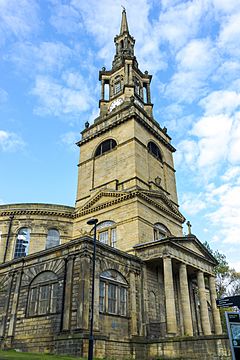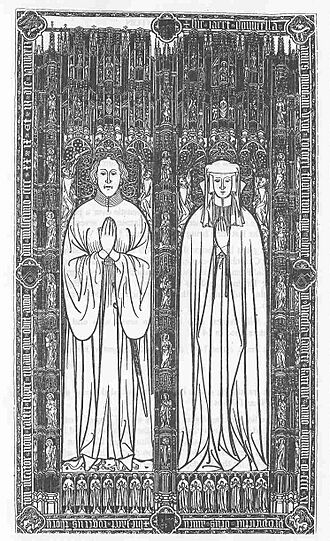All Saints' Church, Newcastle upon Tyne facts for kids
Quick facts for kids All Saints' Church |
|
|---|---|
 |
|
| 54°58′12″N 1°36′25″W / 54.9699°N 1.6070°W | |
| OS grid reference | NZ252639 |
| Location | Newcastle upon Tyne |
| Country | England |
| Denomination | Evangelical Presbyterian |
| Previous denomination | Church of England Old Catholic |
| Architecture | |
| Architect(s) | David Stephenson |
| Architectural type | Neoclassical architecture |
All Saints' Church is a special building in Newcastle upon Tyne, England. It was built in the late 1700s, replacing a much older church. This church is unique because it's the only one in England shaped like an ellipse (an oval!). It's also one of the tallest religious buildings in Newcastle and is considered a very important historical building (a Grade I listed building).
History
The old church
A Christian church has stood on this spot since at least 1286. The original church, called All Saints' or All Hallows', was built in the Gothic style. It went through many changes and repairs over the centuries.
Historian Henry Bourne described the old church. He said it was on a hill, similar in height to another church in Gateshead. It was about 55 yards long and 25 yards wide. The steeple was a simple square tower with a spire.
The bells in the old church were made in 1696. They were cast from the metal of a famous statue of King James II of England. People said their sound was very exact and tuneful.
Another historian, McKenzie, was alive when the old church was taken down. He wrote that the steeple and west end of the old church were where the new church stands today. The old church extended further east into what is now the burial ground.
The steeple was a low, square tower. It had buttresses (supports) and large openings at the top. A small square turret with a short spire rose from the center. The main entrance was through the west door of the steeple. There were also north and south porches.
The steeple had a good clock with chimes and two painted dials. The church had five bells made by Christopher Hodgson of London. There were also seven small chapels, called chantries, inside. One of these, St Peter's, was started by Roger Thornton. The old church's windows were large and had stained glass. However, they were damaged during the civil war.

One of the most important memorials in the church was for Roger Thornton. He was a very generous person in Newcastle. His monument had an altar with beautiful Gothic designs. Above it was an oval-shaped canopy.
The main part of this monument was a large brass plate. It showed figures of Roger Thornton and his wife, Agnes. It also had many figures of apostles and saints. This beautiful monument is now gone. However, the brass plate is still saved. It hangs in the vestry of Newcastle Cathedral today.
An interesting part of the old church was the seamen's porch. It had a gallery on the north side. This was built in 1618 by the Trinity House of Newcastle. The gallery front had painted panels. The middle panel showed the arms of Trinity House. The side panels showed four Bible stories related to the sea.
The font of the old church has a special story. In 1640, when the Scots entered Newcastle, they started destroying religious items. Cuthbert Maxwell, a stonemason, quickly hid the fonts of St Nicholas' and All Saints' churches. This saved them from being destroyed. After the war, he put them back. The All Saints' font was octagonal and carved with family crests. When the church was demolished, it was given to a collector.
Not many records exist about the early history of old All Saints'. Most accounts are about repairs. The church's parish register, which records births, deaths, and marriages, started in 1600.
The new church
Around 1785, the church leaders wanted to repair the building. They got plans from William Newton. But the Archdeacon of Northumberland did not like the idea of changing the old Gothic church. Two other architects, David Stephenson and John Dodds, were called in. They said it would be impossible to estimate the cost of repairs. They explained that the building was so decayed that repairing it would cost as much as building a new one.
They reported that the south wall was in danger of falling. One of the steeple's pillars had shrunk. The steeple itself leaned to the south. The stone arches under the bells were rotten. The timber and bells were in danger of falling. The walls were crumbling.
On April 18, 1786, the church members decided to build a new church. The old church was immediately taken down. Sadly, most of its old monuments and stained glass were lost or carried away. The tower's masonry was so strong that they had to use gunpowder to blast it. During this work, a sad accident happened. Captain William Hedley was killed when a stone from the great west door fell on him. He was a respected man in Newcastle.
Once the old church was completely removed, construction of the new one began. The design by David Stephenson was chosen. The foundation stone was laid on August 14, 1786. During construction, two main changes were made to the original design. The portico (entrance area) was changed from Ionic columns to the current Doric style. The money saved was used to improve the tower.
The new church was finished in 1796. It cost £27,000 to build. Most of the money came from taxes on the parish. Some money came from selling church pews and donations. Mrs. Atlee gave £100 to make the inside fittings from mahogany instead of oak.
The church is shaped like an ellipse, or an oval. Its longer side runs almost north to south. It looks similar to the Pantheon in Rome. The roof is a wonderful piece of carpentry. It has no supporting pillars inside. The square tower is at the south end. The inside of the tower forms the entrance hall. On either side of it, there is a wing. The left wing is used as a morning chapel and for baptisms. The right wing is the vestry, where Roger Thornton's brass memorial used to hang before it moved to Newcastle Cathedral.
On November 17, 1789, the new church was officially opened. The opening sermon was given by Rev. Hugh Moises. He was the headmaster of the Grammar School. His sermon was about keeping the Sabbath and respecting God's house.
In 1881, the church leaders asked for help to repair the church. People gave money, and the restoration work began.
Around 1881, Richard S. Donkin, a wealthy shipowner, offered to improve the churchyard at his own cost. This offer was accepted. Many other generous gifts were made to the church. For example, Mr. John Hall, another Newcastle merchant, gave a new clock. It was started and lit up on February 3, 1882.
Recent history
The church stopped being used for regular church services in 1961. It was then changed into offices and an auditorium between 1983 and 1984. The Royal Northern Sinfonia, a music group, used it for a while. They later moved to The Sage, Gateshead in 2004.
For some time, the church was used by the Church of Saint Willibrord. It also hosted musical events. The building suffered damage from flooding in 2009-2010 and 2010-2011. This was caused by blocked roof drains. Because of this, the building was left in a state of disrepair. In 2015, it was added to Historic England's "Heritage at Risk" list. This list identifies important historical buildings that need help.
In 2019, a local church group, the Evangelical Presbyterian Church in England and Wales, signed a 150-year lease for All Saints'. After a big restoration project, church services began again in October 2019. The church is now called All Saints' Presbyterian Church. The minister is Revd Benjamin Wontrop. Besides Sunday services, the church also has a mid-week Bible study. It is also open for self-guided tours every Thursday from 1-4 pm and at other times during the year.
See Also
Images for kids




